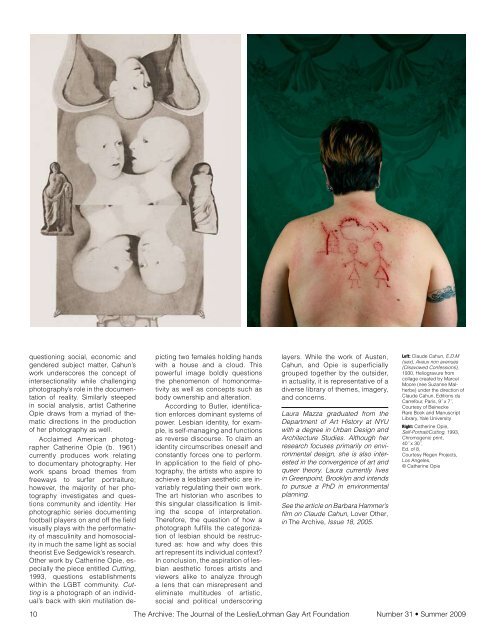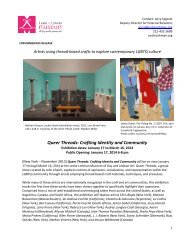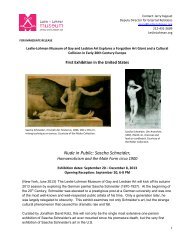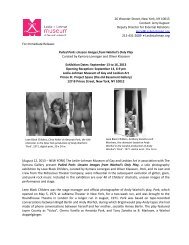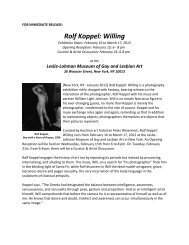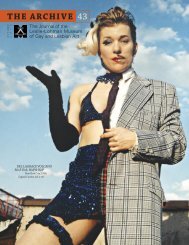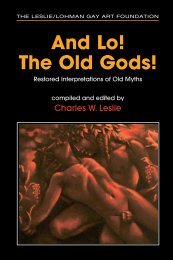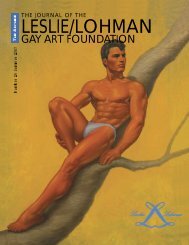B - Leslie-Lohman Gay Arts Foundation
B - Leslie-Lohman Gay Arts Foundation
B - Leslie-Lohman Gay Arts Foundation
You also want an ePaper? Increase the reach of your titles
YUMPU automatically turns print PDFs into web optimized ePapers that Google loves.
questioning social, economic and<br />
gendered subject matter, Cahun’s<br />
work underscores the concept of<br />
intersectionality while challenging<br />
photography’s role in the documentation<br />
of reality. Similarly steeped<br />
in social analysis, artist Catherine<br />
Opie draws from a myriad of thematic<br />
directions in the production<br />
of her photography as well.<br />
Acclaimed American photographer<br />
Catherine Opie (b. 1961)<br />
currently produces work relating<br />
to documentary photography. Her<br />
work spans broad themes from<br />
freeways to surfer portraiture;<br />
however, the majority of her photography<br />
investigates and questions<br />
community and identity. Her<br />
photographic series documenting<br />
football players on and off the field<br />
visually plays with the performativity<br />
of masculinity and homosociality<br />
in much the same light as social<br />
theorist Eve Sedgewick’s research.<br />
Other work by Catherine Opie, especially<br />
the piece entitled Cutting,<br />
1993, questions establishments<br />
within the LGBT community. Cutting<br />
is a photograph of an individual’s<br />
back with skin mutilation de-<br />
picting two females holding hands<br />
with a house and a cloud. This<br />
powerful image boldly questions<br />
the phenomenon of homonormativity<br />
as well as concepts such as<br />
body ownership and alteration.<br />
According to Butler, identification<br />
enforces dominant systems of<br />
power. Lesbian identity, for example,<br />
is self-managing and functions<br />
as reverse discourse. To claim an<br />
identity circumscribes oneself and<br />
constantly forces one to perform.<br />
In application to the field of photography,<br />
the artists who aspire to<br />
achieve a lesbian aesthetic are invariably<br />
regulating their own work.<br />
The art historian who ascribes to<br />
this singular classification is limiting<br />
the scope of interpretation.<br />
Therefore, the question of how a<br />
photograph fulfills the categorization<br />
of lesbian should be restructured<br />
as: how and why does this<br />
art represent its individual context?<br />
In conclusion, the aspiration of lesbian<br />
aesthetic forces artists and<br />
viewers alike to analyze through<br />
a lens that can misrepresent and<br />
eliminate multitudes of artistic,<br />
social and political underscoring<br />
layers. While the work of Austen,<br />
Cahun, and Opie is superficially<br />
grouped together by the outsider,<br />
in actuality, it is representative of a<br />
diverse library of themes, imagery,<br />
and concerns.<br />
Laura Mazza graduated from the<br />
Department of Art History at NYU<br />
with a degree in Urban Design and<br />
Architecture Studies. Although her<br />
research focuses primarily on environmental<br />
design, she is also interested<br />
in the convergence of art and<br />
queer theory. Laura currently lives<br />
in Greenpoint, Brooklyn and intends<br />
to pursue a PhD in environmental<br />
planning.<br />
See the article on Barbara Hammer’s<br />
film on Claude Cahun, Lover Other,<br />
in The Archive, Issue 18, 2005.<br />
Left: Claude Cahun, E.D.M<br />
(sex), Aveux non avenues<br />
(Disavowed Confessions),<br />
1930, Heliogravure from<br />
collage created by Marcel<br />
Moore (nee Suzanne Malherbe)<br />
under the direction of<br />
Claude Cahun, Editions du<br />
Carrefour, Paris, 9˝ x 7˝,<br />
Courtesy of Beinecke<br />
Rare Book and Manuscript<br />
Library, yale university<br />
Right: Catherine Opie,<br />
Self-Portrait/Cutting, 1993,<br />
Chromogenic print,<br />
40˝ x 30˝,<br />
Ed. of 8,<br />
Courtesy Regen Projects,<br />
Los Angeles,<br />
© Catherine Opie<br />
10 The Archive: The Journal of the <strong>Leslie</strong>/<strong>Lohman</strong> <strong>Gay</strong> Art <strong>Foundation</strong> Number 31 • Summer 2009


